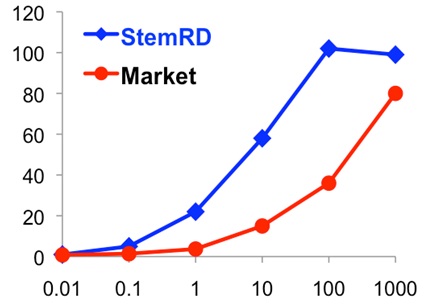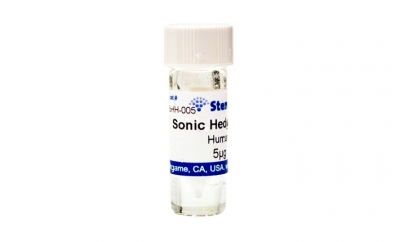| Source | Human Mammalian Cells | M.W. | ~45kDa | CAS No. | |
|---|---|---|---|---|---|
| Structural Info | |||||
| Formulation | Lyophilized in sterile filtered solution of PBS with 1% CHAPS | ||||
| Reconstitution | Before reconstitution, we recommend a brief spin to drive down any material dislodged from the bottom of the tube. The lyophilized protein should be reconstituted in sterile H2O to a concentration of 100 ng/uL. Because of the hydrophobic nature of this protein, further dilutions should be made in buffer or medium containing carrier proteins, such as albumin or serum. |
||||
| Stability | The lyophilized protein is stable for at least 1 year if stored at -80 °C. Reconstituted protein is stable for at least 1 month at 4 °C, but should be stored in aliquots at -80 °C for longer term. Avoid repeated freeze and thaw. | ||||
| Purity | Greater than 85% as determined by SDS-PAGE and HPLC analysis | ||||
| Biological Activity | The activity was determined by using a Gli reporter gene assay in 3T3 cells. The EC50 ranges from 5 to 20 ng/ml. | ||||
| Country of Origin | USA | ||||
The hedgehog (Hh) gene encodes a secreted protein originally identified in Drosophila. The vertebrate homologs of Hh comprise of Sonic (SHh), Desert (DHh) and Indian (IHh). SHh plays an important role in embryonic development and in diseases such as cancer. Human SHh precursor is a 45kDa protein. An autocatalytic reaction yields a 19 kDa N-terminal domain that is biologically active. Because of unique post-translational modifications, SHh produced in mammalian cells is much more biologically active than SHh produced from E. coli and is devoid of artifact associated with the E. coli products commercially available from other manufacturers.

|
SHh from StemRD made in human cells is 10-50 times more active, than other commercial products made in E. coli. Activity is detected by a Gli reporter gene assay in Swiss 3T3 cells. |
Chen Y, Yue S, Xie L, et al., Dual Phosphorylation of suppressor of fused (Sufu) by PKA and GSK3beta regulates its stability and localizationin the primary cilium. J Biol Chem. 2011 Apr 15;286(15):13502-11.
http://www.ncbi.nlm.nih.gov/pubmed/21317289
Ding H, Zhou D, Hao S, et al., Sonic hedgehog signaling mediates epithelial-mesenchymal communication and promotes renal fibrosis. J Am Soc Nephrol. 2012 May;23(5):801-13.
http://www.ncbi.nlm.nih.gov/pubmed/22302193
Wang J, Mook RA Jr, Lu J, et al., Identification of a novel Smoothened antagonist that potently suppresses Hedgehog signaling. Bioorg Med Chem. 2012 Nov 15;20(22):6751-7.
http://www.ncbi.nlm.nih.gov/pubmed/23063522
Okabe S, Tauchi T, Tanaka Y, et al., Effects of the hedgehog inhibitor GDC-0449, alone or in combination with dasatinib, on
BCR-ABL-positive leukemia cells. Stem Cells Dev. 2012 Nov 1;21(16):2939-48.
http://www.ncbi.nlm.nih.gov/pubmed/22642671
http://www.ncbi.nlm.nih.gov/pubmed/21317289
Ding H, Zhou D, Hao S, et al., Sonic hedgehog signaling mediates epithelial-mesenchymal communication and promotes renal fibrosis. J Am Soc Nephrol. 2012 May;23(5):801-13.
http://www.ncbi.nlm.nih.gov/pubmed/22302193
Wang J, Mook RA Jr, Lu J, et al., Identification of a novel Smoothened antagonist that potently suppresses Hedgehog signaling. Bioorg Med Chem. 2012 Nov 15;20(22):6751-7.
http://www.ncbi.nlm.nih.gov/pubmed/23063522
Okabe S, Tauchi T, Tanaka Y, et al., Effects of the hedgehog inhibitor GDC-0449, alone or in combination with dasatinib, on
BCR-ABL-positive leukemia cells. Stem Cells Dev. 2012 Nov 1;21(16):2939-48.
http://www.ncbi.nlm.nih.gov/pubmed/22642671
